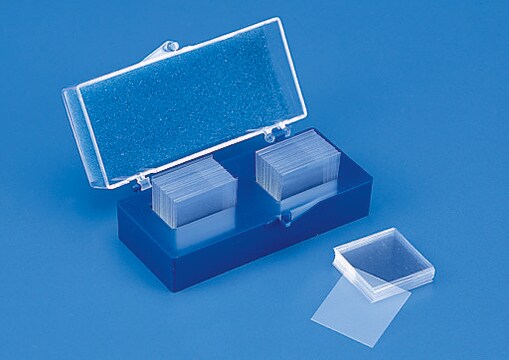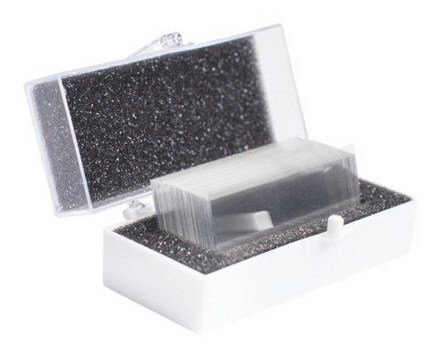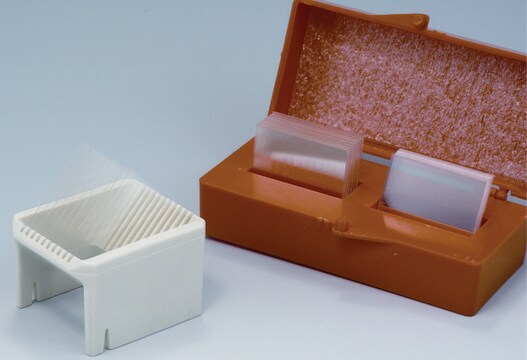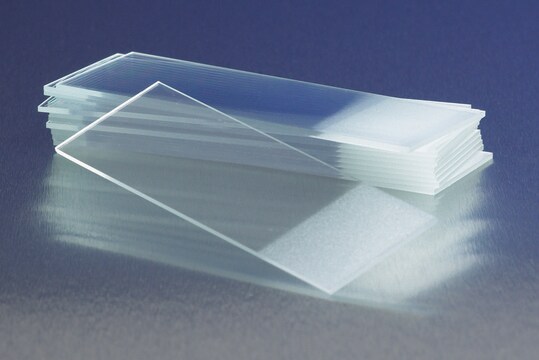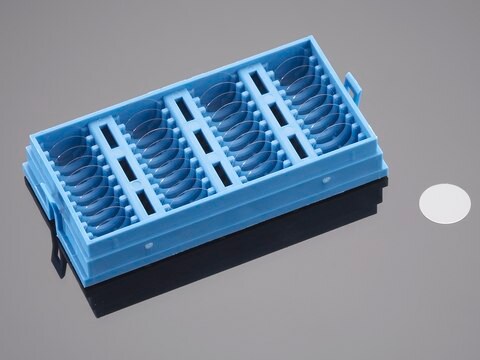S7117
ApopTag Plastic Coverslip
APOPTAG Plastic Coverslips are designed to be custom fitted to the specific APOPTAG kit application.
Sinonimo/i:
Plastic coverslip
Autenticatiper visualizzare i prezzi riservati alla tua organizzazione & contrattuali
About This Item
Codice UNSPSC:
12161503
eCl@ss:
32161000
NACRES:
NA.32
Prodotti consigliati
Livello qualitativo
Produttore/marchio commerciale
ApopTag
Chemicon®
tecniche
activity assay: suitable (apoptosis)
Condizioni di spedizione
ambient
Descrizione generale
APOPTAG Plastic Coverslips are designed to be custom fitted to the specific APOPTAG kit application. Each coverslip has 2.5" x 1" dimensions.
Applicazioni
Plastic coverslips can be used to assure that a constant volume of solution is applied per unit of specimen area. However, their handling time slows down the protocol. Each square centimeter of plastic coverslip will require the volume of reagent indicated in Table 5 (S7100, S7101) and Table 10 (S7110, S7111, S7160), so that the reagent volume applied per unit of tissue area can be held constant. The surface to be covered is always equal to the area of the plastic coverslip, not the area of the specimen.
Plastic coverslips may be trimmed to any desired size and shape. The kit′s yield of specimens will be reduced if larger than standard coverslips are used.
When using ApopTag Kits that contain the anti-digoxigenin antibodies (S7100, S7101, S7110, S7111), plastic coverslips can be used during the incubation steps with the following reagents: WORKING STRENGTH TdT, and the ANTI-DIGOXIGENIN ANTIBODY. When using the ApopTag Fluorescein Direct Kit (S7160), the plastic coverslips can be used during incubation steps with WORKING STRENGTH TdT.
A basic coverslip method is described as follows:
To make a pair of "standard area" (~5 cm2) specimen coverslips, cut a plastic coverslip (provided) into two equal halves, and fold up a 1 cm handling tab across the width, then crease sharply (See Figure 3 in insert).
Drain one slide for approximately 10 seconds, and then tap off drops on a paper towel on the benchtop. Blot back and sides of the slide with a folded wipe. Carefully blot the area around the tissue section or cells, or else vacuum up solution using a pipette attached to an aspirator vacuum.
Apply reagent solution to one end of the area to be covered, using a dropper bottle or pipette as required.
Grasp the plastic coverslip by the handling tab and touch its opposite end to the droplet of reagent on the slide. Slightly arching the coverslip, roll it slowly downward, causing the solution to spread by capillary action. If solution does not spread evenly, tilt the slide until the flow reaches all edges.
Apply plastic coverslips to microscope slides so as to minimize trapped air bubbles, which may cause variable enzyme reaction or detection.
Place the slide across the pipettes, face-up and level, inside the humidified chamber. The slide edges should not touch anything so as to prevent drainage of the reagent.
Plastic coverslips may be trimmed to any desired size and shape. The kit′s yield of specimens will be reduced if larger than standard coverslips are used.
When using ApopTag Kits that contain the anti-digoxigenin antibodies (S7100, S7101, S7110, S7111), plastic coverslips can be used during the incubation steps with the following reagents: WORKING STRENGTH TdT, and the ANTI-DIGOXIGENIN ANTIBODY. When using the ApopTag Fluorescein Direct Kit (S7160), the plastic coverslips can be used during incubation steps with WORKING STRENGTH TdT.
A basic coverslip method is described as follows:
To make a pair of "standard area" (~5 cm2) specimen coverslips, cut a plastic coverslip (provided) into two equal halves, and fold up a 1 cm handling tab across the width, then crease sharply (See Figure 3 in insert).
Drain one slide for approximately 10 seconds, and then tap off drops on a paper towel on the benchtop. Blot back and sides of the slide with a folded wipe. Carefully blot the area around the tissue section or cells, or else vacuum up solution using a pipette attached to an aspirator vacuum.
Apply reagent solution to one end of the area to be covered, using a dropper bottle or pipette as required.
Grasp the plastic coverslip by the handling tab and touch its opposite end to the droplet of reagent on the slide. Slightly arching the coverslip, roll it slowly downward, causing the solution to spread by capillary action. If solution does not spread evenly, tilt the slide until the flow reaches all edges.
Apply plastic coverslips to microscope slides so as to minimize trapped air bubbles, which may cause variable enzyme reaction or detection.
Place the slide across the pipettes, face-up and level, inside the humidified chamber. The slide edges should not touch anything so as to prevent drainage of the reagent.
Stoccaggio e stabilità
Store at room temperature.
Note legali
CHEMICON is a registered trademark of Merck KGaA, Darmstadt, Germany
Esclusione di responsabilità
Unless otherwise stated in our catalog or other company documentation accompanying the product(s), our products are intended for research use only and are not to be used for any other purpose, which includes but is not limited to, unauthorized commercial uses, in vitro diagnostic uses, ex vivo or in vivo therapeutic uses or any type of consumption or application to humans or animals.
Certificati d'analisi (COA)
Cerca il Certificati d'analisi (COA) digitando il numero di lotto/batch corrispondente. I numeri di lotto o di batch sono stampati sull'etichetta dei prodotti dopo la parola ‘Lotto’ o ‘Batch’.
Possiedi già questo prodotto?
I documenti relativi ai prodotti acquistati recentemente sono disponibili nell’Archivio dei documenti.
Il team dei nostri ricercatori vanta grande esperienza in tutte le aree della ricerca quali Life Science, scienza dei materiali, sintesi chimica, cromatografia, discipline analitiche, ecc..
Contatta l'Assistenza Tecnica.
